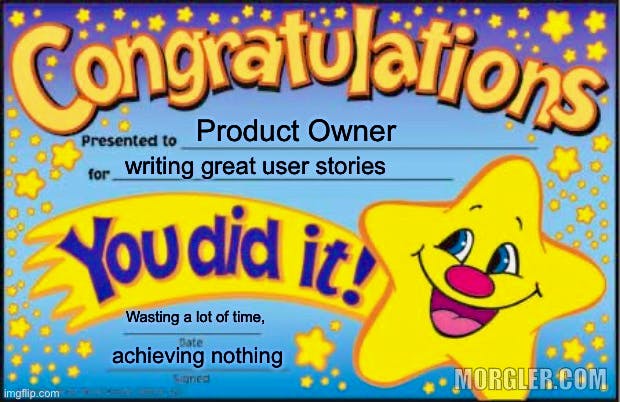Your cart is currently empty!
Let’s Chat About Writing User Stories… Or Not 😳

|
|
|
Hello Reader, last week we talked about change resistance in agile transformations and how to overcome it. This week let’s chat about writing user stories… or not 😳😄. Are user stories really about writing?
* { word-break: break-word; }
Let’s Chat About Writing User Stories… Or NotAlright, do you measure the effectiveness of product owners by how much time they devote to writing great user stories? Many do – more or less explicitly. But there is a hard truth: The better the Product Owner, the less time they spend writing user stories 😱! Yep, you read that right. The less time they spend writing user stories, the better they’re doing their job. It’s like saying, the less you see them scribbling away, the more awesome they are, and the smoother things are likely going with the product.
Why Writing Less Is Actually MoreSo, the old-school thought was that if you’re not writing a novel for each user story, you’re leaving the devs scratching their heads with a ton of questions. But, guess what? That’s not really how it works in the agile world. The Agile Manifesto is all about people talking to each other over filling out forms or documents. In short, the secret sauce is chatting more and writing less. User Stories Aren’t Homework
I’ve lost count of how many times someone’s asked me to teach them to write the “perfect” user story. And every time, I’m like, “You’re missing the point!” User stories aren’t about crafting a masterpiece of documentation; they’re about getting product people and devs to work together like a well-oiled machine. It’s all about the three Cs: Card, Conversation, and Confirmation, which is just a fancy way of saying, write a bit, talk a lot, and make sure everyone’s on the same page. The Trouble With Too Much WritingRelying too much on written stuff can lead to a whole mess of problems. Ever heard of “lost in translation”? Well, that’s pretty much what happens. Plus, there’s this awkward thing where devs might feel too intimidated to ask questions if they don’t get something. It’s all about feeling safe to speak up, which doesn’t always happen when communication feels like passing notes in class. Here are just a few problems of too much writing: 👎 Time: Writing takes longer than talking 👎 Hidden assumptions: The writer has a different context than the reader, so we leave out things clear to us and explain things in detail that the reader might know anyway. 👎 Intimidation: If your manager hands you a huge document describing everything in minute detail, do you really ask lots of questions? Or wouldn‘t you be more like: “I really should understand this! Think, think! Don’t look stupid by asking questions!“ 👎 Slow feedback: Asking a clarifying question while talking takes seconds. But playing Jira comment ping pong on a written issue can take forever.
And, just because we’re saying “talk more, write less,” doesn’t mean you throw the notebook out the window. During those chats and brainstorming sessions, lots of great ideas and decisions pop up. It’s cool to jot those down in the user story. But that’s just to keep track, not to replace actual talking. The Bottom Line: Just TalkThe takeaway here is pretty simple: chat more, write less. This doesn’t mean we can’t use all the cool tech we have to keep in touch. Whether it’s a quick call, a video chat, or firing off messages, the goal is to keep the conversation flowing easily and clearly. So, let’s ditch the pen and paper (figuratively speaking) and get to talking. After all, the best way to get things moving is by actually moving… our lips, that is. Here’s to making our products rock 🤘 with the power of good old conversation!
* { word-break: break-word; }
|